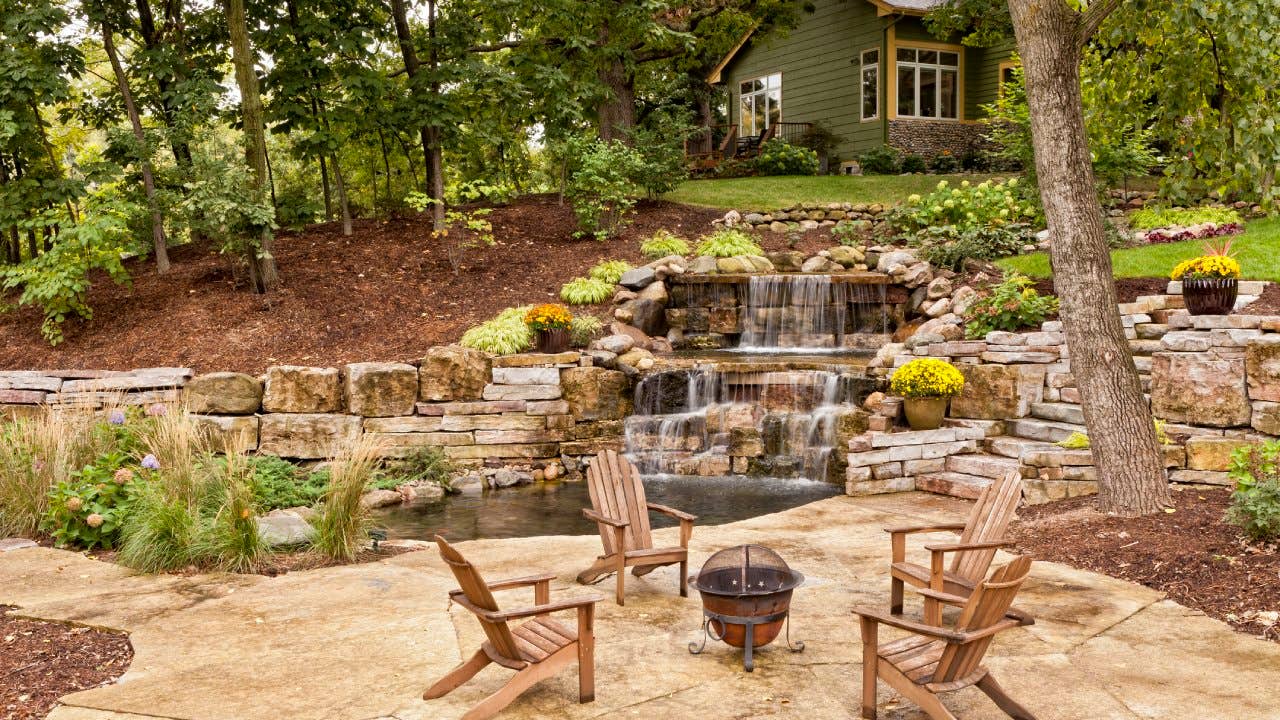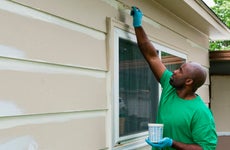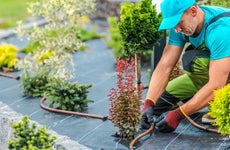Does landscaping increase home value?

The Bankrate promise
At Bankrate we strive to help you make smarter financial decisions. While we adhere to strict , this post may contain references to products from our partners. Here's an explanation for .
Landscaping can have a big impact on the impression a home makes. The front lawn leading to your door is usually what a visitor notices first; the view out the back can enhance the ambiance of interior rooms. The question is, how vital is it to invest in curb appeal to improve your home’s value? Is it worth prioritizing part of your home maintenance budget on your outdoor areas?
The American Society of Landscape Architects (ASLA) claims professional landscaping can increase a home’s price tag 15 percent to 20 percent more at the time of resale. “High-quality landscape designs usually have an ROI of 20 percent to 30 percent of the overall house value,” says Bryan McKenzie, a landscape designer and co-founder of gardening advice site bumpercroptimes.com.
However, not all projects deliver on the promise, and some can potentially decrease property value. Where you see beauty, others may see a burden or even a hazard.
Let’s dig more deeply into when landscaping decreases or increases home value — and what projects may offer the best opportunity to return more on your investment.
Key takeaways
- Landscaping can increase a home’s resale value by 15-20% on average.
- It’s recommended to keep your spending on outdoor and landscaping improvements in the range of 10-20% of your home’s current value.
- The most financially rewarding landscaping projects both expand living space and add low-maintenance beauty to a property.
- Landscaping projects that are geographically infeasible, seem high-maintenance or are “too niche” may put off buyers.
Does landscaping improve home value?
First, a quick refresher as to what landscaping actually means. Basically, it encompasses the exterior area around a residence — both the overall design and the individual elements. Softscaping refers to living things: flowers and plants, trees, gardens and natural ground coverings and formations (grass, hills, rough stones). Hardscaping refers to non-biological things: ornamental or architectural features and structures, like steps, paved paths and fountains.
As with interior designs, landscaping trends can and do change over time. Nowadays, “outdoor living space enhancements are very popular upgrades — including expansions of decks and patios, adding fireplaces or fire features, dining areas and covered gazebos or pergolas,” Britt Wood, CEO of the National Association of Landscape Professionals, says.
However, a project’s popularity does not mean it adds the sort of value the next homeowner is willing to pay a premium for. Pergolas may not be to everyone’s taste, for example. Or that elaborate water garden may require too much upkeep (who’s going to feed the fish?).
Still, “2018 research by Alex X. Niemiera, a horticulturist at Virginia Tech, found that a well-landscaped home had a 5.5 percent to 12.7 percent price advantage over a home with no landscaping,” note Chase and Patti Michels of Chicago real estate agency the Michels Group. “That translates into an extra $16,500 to $38,100 in value on a $300,000 home.”
The most financially rewarding landscaping projects do one of two things: expand living space and/or add low-maintenance beauty to a property.
Which landscaping projects improve a home’s value?
Whether hardscaping or softscaping, the following landscaping projects are more likely to increase home value when done right.
Decks
Decks are the only landscaping project to make the list on Remodeling.com’s annual Cost vs Value study, which analyzes home improvements offering the best return on investment. A wood deck costs on average $17,051, recouping 50.2 percent of its costs at resale. Wood decks’ ROI has gotten hammered in the last two years, due to pandemic-induced rising lumber prices. But they still outperform a composite deck, which costs $23,430 on average, recouping 39.8 percent. (Decks made of composite materials, like PVC and vinyl, may be more expensive to build, but require less maintenance than wooden ones.)
Mature trees
Niemera’s study states that the top thing that buyers are looking for in landscaping is a sophisticated design. “Close behind is plant size and maturity,” the Michels note. So, you may want to invest in larger trees and mature greenery that appears more established for your landscaping project.
The cost of planting a tree vs a shrub may be higher, but so are the benefits. According to Fixr.com, planting a shrub averages between $25 and $50, while a tree costs $150 to $300 on average. However, you may need fewer trees than shrubs. In addition, trees are less likely to require maintenance when compared to a shrub (once established) and provide shade, a windbreak, curb appeal and a safe habitat for birds and squirrels.
Xeriscaping
Xeriscaping, the use of drought-friendly plants and features that require little or no irrigation, may be one of the most expensive landscaping projects up front — but as climate change rocks the country with warmer temperatures, it’s getting more popular. The ASLA has reported that members have seen a 10 percent growth in client demand for drought-resistant landscaping.
Fixr.com states that the average xeriscaping project costs $16,000 to $18,000. However, moving away from water-intensive landscaping towards xeriscaping or low-water landscaping may be the wisest decision now and in the long run, simply because you eliminate many of the maintenance costs associated with traditional landscape designs. That could be worth an additional 10 percent to 12 percent in property value, some real estate sites report.
Bryan Clayton, CEO of GreenPal, a site that pairs consumers and lawn pros, sees a growing preference for waterwise landscaping. He advises customers to “save money on their landscape maintenance by installing river rock in their gardens and landscaping beds.” Although rock gardening may seem like a project better-suited for desert landscapes, Clayton says he’s seeing clients pare down, even in cooler zones. “People are just tired of wasting money year after year on mulch, straw or other organic materials to put in the gardens,” he explains.
Some other ways to integrate the waterwise or drought-friendly landscaping include:
- Integrating more low-water plants into the garden
- Automated irrigation programmed to run early in the morning or during the evenings
- More hardscaping using stone or pavers to reduce a lawn’s square footage
- Replacing mulch with rock or gravel
Sprinkler systems
Not ready for a rock garden? If you want to keep the green, a sprinkler system can help you use water more efficiently, and of course it makes keeping a kempt lawn a whole lot easier. The initial cost can set you back anywhere from $1,600 to $10,000, according to Angi, with the average expense landing just over $2,500. Lawn size is the biggest variable when it comes to the cost of installing a new system.
Sprinkler systems also have a high ROI. According to the National Association of Realtors (NAR) Remodeling Impact Report: Outdoor Features for 2023, a sprinkler/irrigation system has a 83 percent return on investment. This addition also earns a 9.4 “joy score” out of a possible 10 from homeowners.
Landscape lighting
Landscape lighting makes it more feasible to hang out in your yard after dark. While many homeowners appreciate it for the aesthetics alone, this sort of upgrade augments safety and security. According to the NAR 2023 study, this type of installation offers a 59 percent return on investment. Fixr puts the average cost for outdoor lighting at between $3,500 and $4,500.
Lawn and landscape maintenance
Even simple maintenance of your lawn and landscaping can bring results. According to NAR, mowing, pruning and an annual mulch application offers a whopping 104 percent ROI, and almost two-thirds of Realtors recommend tidying up in this way before selling a property. For a lawn that’s 2,835 square feet, NAR estimates the annual cost at $4,800.
Which landscaping projects decrease value?
In general, landscaping projects that are “too niche” may put off a large portion of buyers. Ideas such as an Asian zen garden or a cactus garden anywhere outside of the Southwest may not appeal to all. In addition, the Michels explain that, “major renovations tend to have significantly lower returns than smaller projects.” Investing in smaller improvements outdoors would be money better spent.
Enhancements may backfire in other ways. For example, certain landscaping projects can be considered high maintenance or too costly to maintain. A lush, green lawn may be attractive in many areas but is not practical in drought zones due to their high water requirement. Plus, lawns require constant care: mowing, seeding and aerating.
Other landscaping projects than can end up decreasing value due to their complexity or maintenance costs include:
- Swimming pools: They can be seen as a safety hazard and require fencing and added security measures in many municipalities.
- Ponds, waterfalls and other water features: Similar to swimming pools, they can present a safety issue for young kids and pets. They can also require constant upkeep.
- Fancy features: Elaborate constructions such as an outdoor kitchen or a tennis court may be counterproductive, if the cost of the addition is significant enough to push the home’s value higher than that of neighborhood comps.
Landscaping tips
The ASLA recommends keeping your spending on outdoor and landscaping improvements in the range of 10 percent to 20 percent of your home’s current value. However, you could spend less and still earn a sizable return. When deciding on what type of external upgrades would deliver the most value, consider the following tips:
- Keep it simple. The most effective landscaping ideas are sometimes the simplest, such as a clean, clutter-free garden or a low-cost trellis featuring a flowering vine. A few annuals can add color anywhere.
- Less is more. Keep the landscaping plan generic enough for most everyone to appreciate. Not to step on your style, but you should avoid design ideas that may be too personal (and usually overly costly) or trendy.
- Add lighting. You can find low-cost landscape lights at most home improvement stores that you can install yourself. Solar-powered versions don’t require special wiring. Even the small touch of adding spotlights to add drama to your landscape can create a big impact.
- Do your due diligence. Always look into the cost of the landscaping, and compare different materials and service providers to find the best price.
- Work with your local nursery. Although a professional landscape designer can provide a well-designed plan, their fees may take up a significant part of your budget. Many nurseries offer free or low-cost landscaping design ideas when you purchase plants and supplies from them.
The final word on landscaping and home value
Landscaping trends may change over time, but the most financially rewarding projects tend to be the same: They’re low-maintenance, attractive, and expand your enjoyment and use of the home.
As with all home remodeling efforts, some landscaping projects increase value and some do not. It may be best to avoid expensive or overly-personalized projects and keep beautification general — and low maintenance — for a large number of people to appreciate it.
Related Articles



